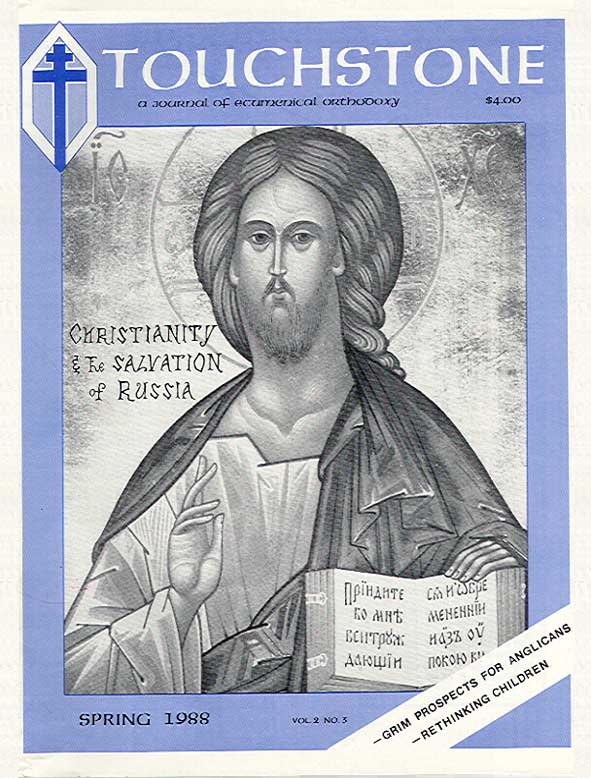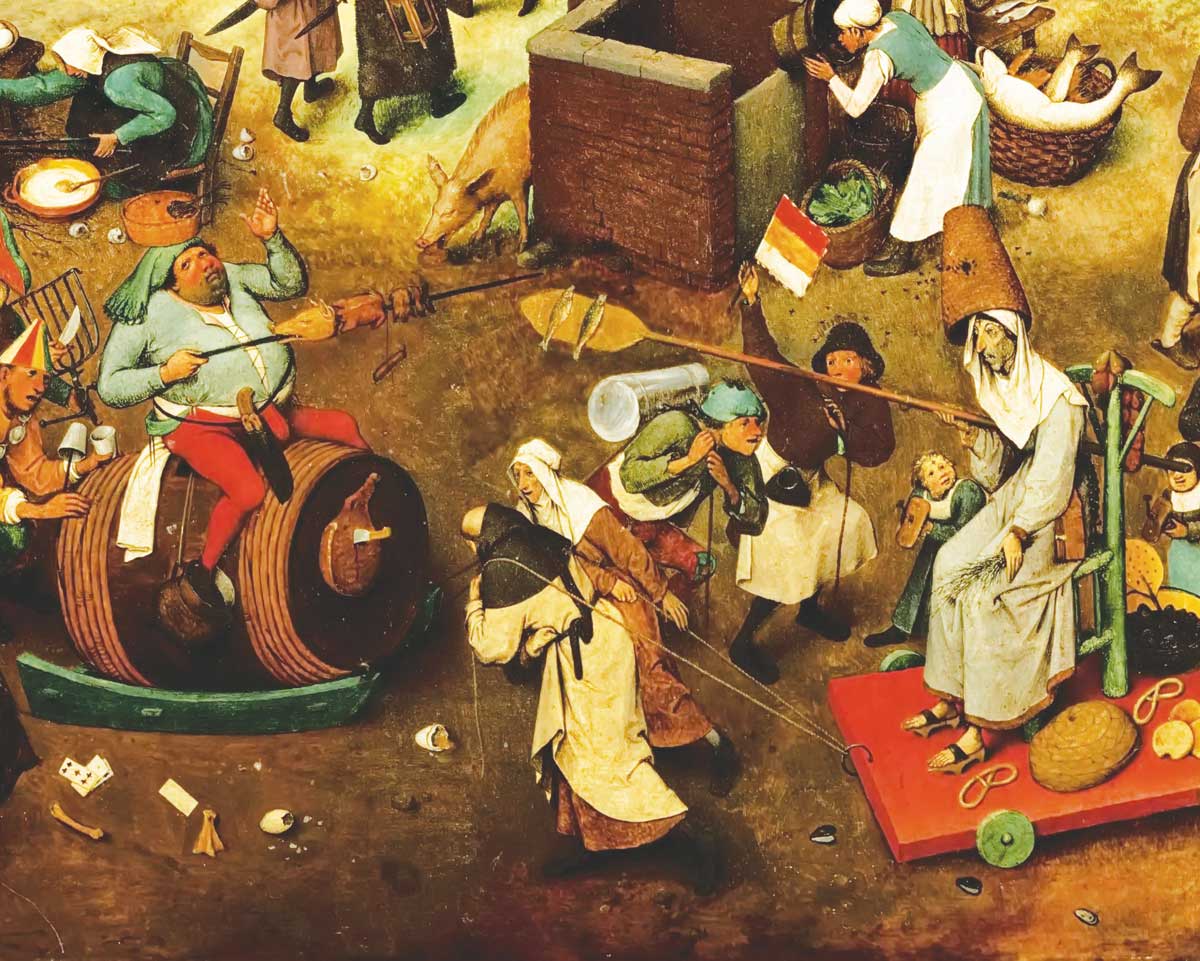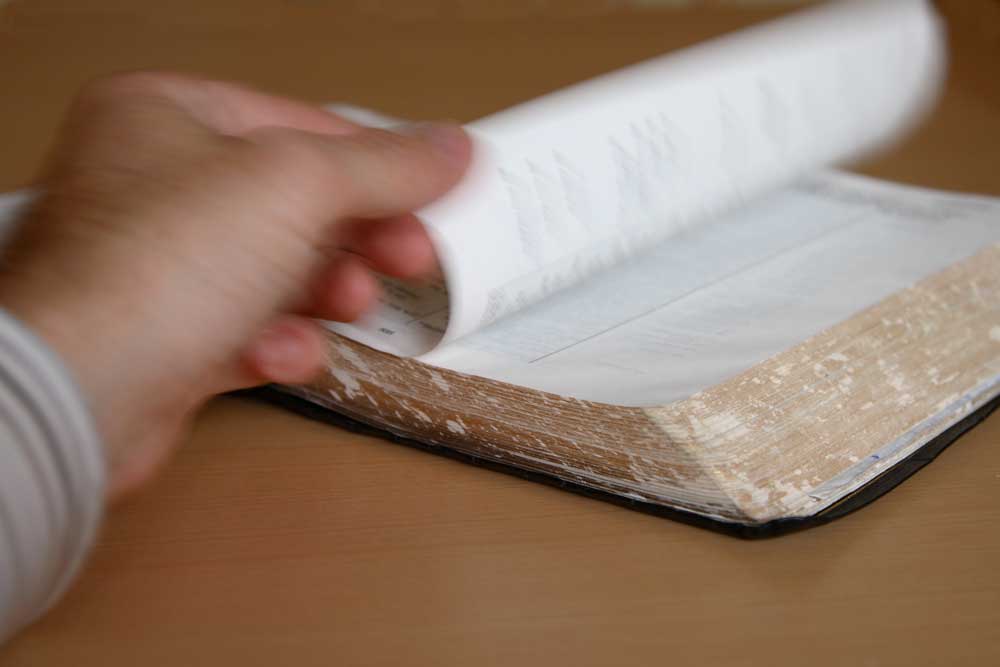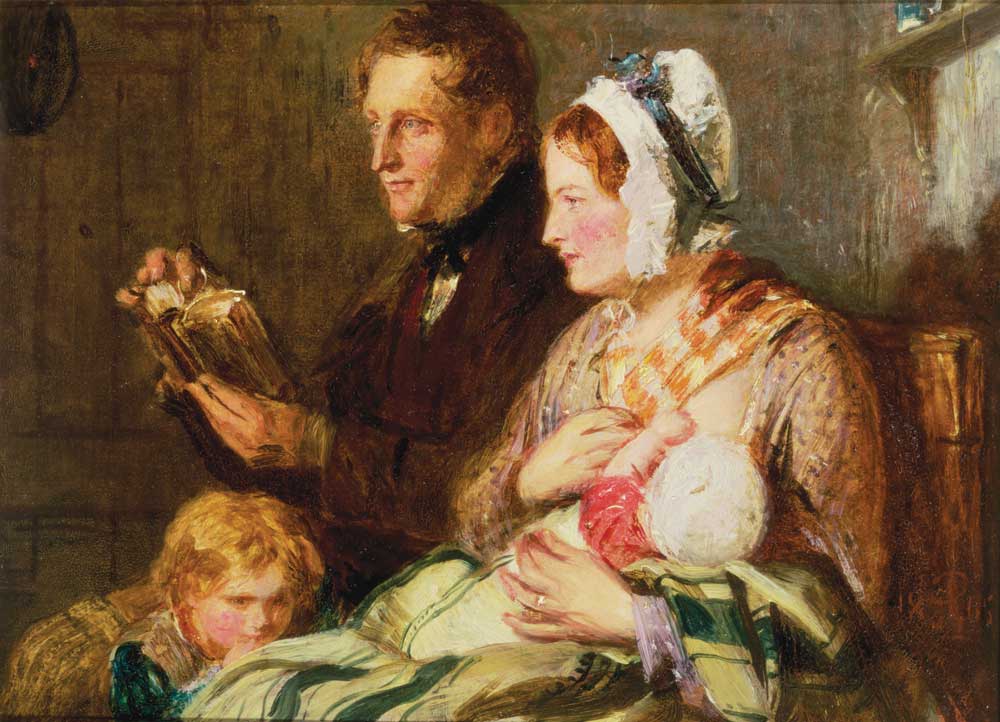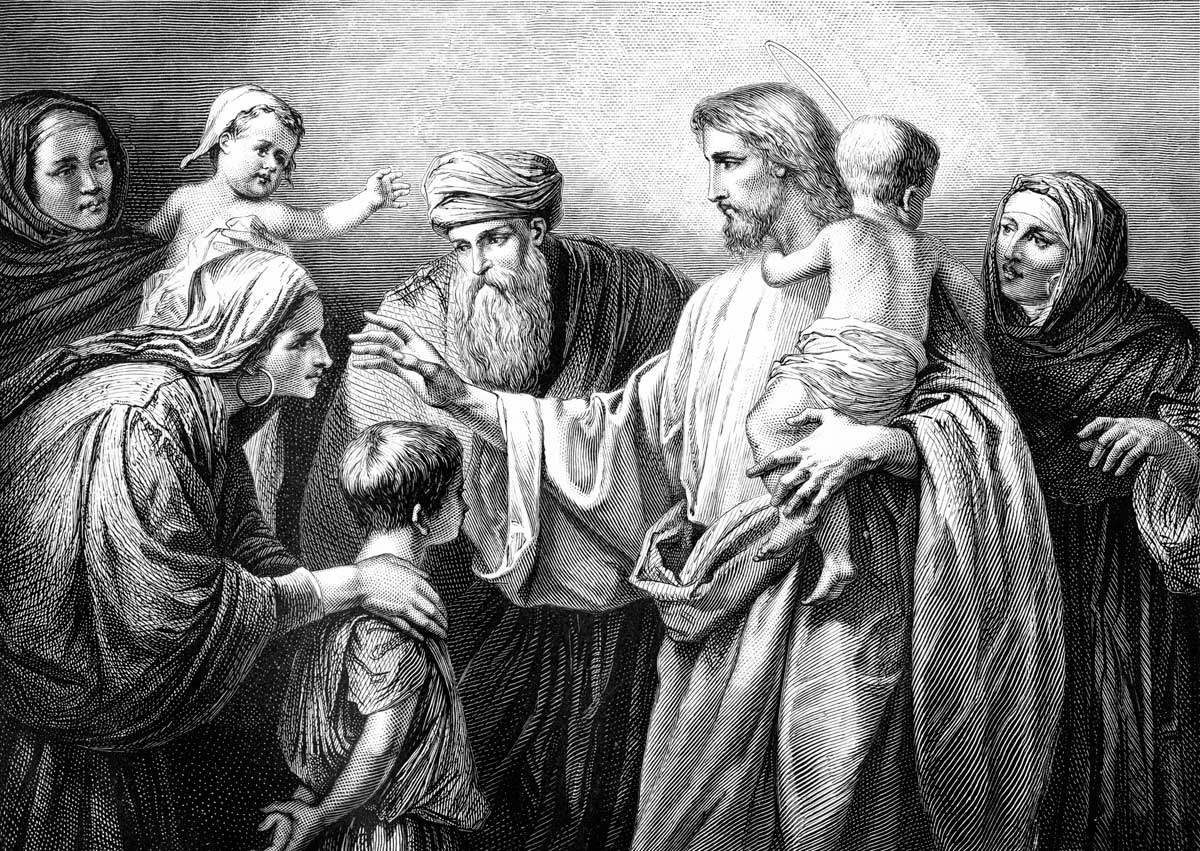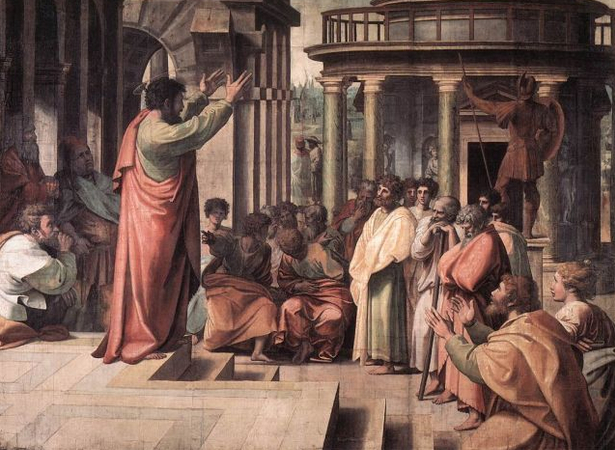Whither Episcopalians?
by Patrick Henry Reardon
If one’s familiarity with the Episcopal Church is informed solely by its quasi-official journal The Episcopalian these days, there would appear to be no reason for anxiety about the future of that denomination. Reflecting the official optimism of Presiding Bishop Edmund Browning, the prospects for Episcopalianism fairly scintillate on those pages. Its clergy are happy, its missions and ministries thriving, its adversaries scarcely mentioned, and only smiling faces are photographed for publication. The regular column by Richard Crawford continues to chant the praises of Anglican enlightenment and inclusiveness. Who could want a better church?
In fact, however, a number of Episcopalians wonder if the denomination portrayed in that monthly paper is the same one they belong to. Articles on the front pages of the secular press certainly paint a different picture: a female priest artificially impregnated (to the applause of Bishop Paul Moore of New York), a fellow who obtains a sex-change and promptly takes vows as a nun, an English priest who commits suicide after writing an article critical of the Anglican Communion generally and the Episcopal Church in particular, the liturgical solemnization of homosexual “marriages” in some dioceses, Bishop Spong of Newark denying that the Bible is the Word of God (among many things that he denies), and so forth. Perplexed by this sort of thing, the average Episcopalian may not be totally reassured by the avuncular grin of Bishop Browning beaming out at him from the pages of The Episcopalian.
Signs of serious trouble are apparent, however, in other journals. The front page of February’s The Evangelical Catholic, for example, bore the headline “Anglicanism at the Eleventh Hour”, and the April 17 issue of The Living Church featured an article entitled “What on Earth is Happening to Us?” by a bishop not known to be either conservative or reactionary.
Well, exactly what on earth is happening to us? Trouble, mainly. For starts, the Episcopal Church is disappearing. The Gallup Organization recently disclosed that the Episcopal Church lost a third of its already low “preference level” since 1967, dropping down from 3 to 2 per cent, and the Church’s own membership audits indicate that the rate has accelerated dramatically in the past few years. The 1988 Episcopal Church Annual shows that between 1985 and 1986 (Browning’s first year as Presiding Bishop) the Episcopal Church lost a total of 234,915 members (8.58%). Adult confirmations during the same period were down by 14.71%. Figures for the years from 1986–88 are not yet available, but there is no reason to believe that they would be encouraging. At its current rate of attrition the Episcopal Church is less than one generation from extinction.
Faced with such figures, one would hope that alarm would suggest itself as a reasonable attitude to those preparing for the Episcopal Church’s General Convention this July. Nothing of the sort. When the Blue Book of the Convention’s agenda was released at the beginning of May, it became clear that the Convention’s attention would not be directed much to the threatening demise of the institution itself. Instead it will spend time considering (and almost certainly approving) a new “trial liturgy” marked by greater “gender inclusiveness” in language about God. It seems that some folks consider it sexist and oppressive to use words like Lord, Father, Son, King and so on. So the Episcopal Church will begin phasing out such language with its new trial liturgy scheduled for use later this year, a plan of which most Episcopalians are still totally ignorant.
The convention in July will also consider a report of its own special commission on sexual ethics, in which monogamous marriage is reduced to an ideal rather than an absolute norm for sexual activity. Once again this was all done in secrecy until the secular press blew the whistle. This report on sexual ethics will be the most hotly debated, one suspects, and it may even be defeated until the next Convention in 1991.
Meanwhile there is a good chance that the Episcopal Church will elect its first woman bishop this year, something that could quite dramatically affect its membership roles.
Critical reactions to such developments were to be expected. Dean John Rodgers of Trinity Episcopal School for Ministry led the formation of a new coalition, called Episcopalians United, to resist innovations in sexual morality, to stop experimentation with language about God, and to discourage the election of a female bishop as too divisive at this time. These would seem to be modest, reasonable goals, nor can one imagine a less bellicose association of grievance and reform than Episcopalians United. For challenging the official optimism of Bishop Browning, however, Episcopalians United has had to do without much support from the bishops of the Church, some of whom have become its sharp critics, even to the point of calling it schismatic.
Nothing could be further from the truth. Bringing together clergy and laity from Anglo-Catholic, Evangelical and Charismatic backgrounds, Episcopalians United is only the most recent and heroic attempt to do what Anglicanism has tried for centuries to do: maintain and even love a communion in spite of internal differences that appear irreconcilable to the outsider. The real question is how long Episcopalians United can continue to overlook the deep doctrinal differences about Sacraments and Order among its own members. Those differences make it very improbable that Episcopalians United could ever become the nucleus of a new denomination, even if it wanted to.
Much the same may be said for a recent, informal and world-wide coalition of conservative Anglican bishops opposed to the consecration of a woman bishop. On February 17, Ash Wednesday, this group issued a proclamation warning that such a consecration would call into question the very continuance of the Anglican Communion. That is about as close to fightin’ words as Anglicans have heard since the time of Charles II and the Restoration, and nearly one hundred bishops have put their signatures to it. Is it a real threat?
Probably not, and for two good reasons. The Anglican Communion, first of all, is really the only thing that joins some of these bishops. Without its continuance, one would be hard pressed to say what, for example, would hold together the Anglo-Catholic Bishop of London and the very Evangelical Archbishop of Sydney, to name but two of the signers. Anglicans have never been held together except with the flimsiest of doctrinal agreement. The real cohesion of the Anglican Communion has relied on forces more subtle and elusive, all of which, I believe, would quickly disappear if the historical Anglican Communion were dissolved.
Secondly, some of those signers among the bishops have been the loudest and most emphatic in their declared intention never to leave the Episcopal Church or the Anglican Communion, and some of them have proven track records indicating a preference for the orderly retreat over the bold move. Consequently there is widespread suspicion that no sharp swords will be drawn to back up that Ash Wednesday statement.
As regards the Anglo-Catholic bishops in the United States, another reason may be adduced for not anticipating an audacious, intrepid stand: money. Any thought of endangering the structure of the Episcopal Church conjures up visions of gargantuan litigation over property titles and even the Pension Fund. One does not reflect on the latter without profound trembling and the removal of sandals. Humiliating as the fact should be, it is commonly remarked among Episcopalians that their denomination is currently being held together by the Pension Fund and the diocesan control of parochial real estate. Until recently the remark was accompanied by smiles, but of late the tone of the comment has turned very serious, even grim. A good number of conservative priests are in their late fifties and early sixties. As has been the case since 1976, more and more of these will be quietly leaving the Episcopal Church as they reach retirement, but understandably they will not, in large numbers, challenge the Episcopal Church openly until their pensions are safe.
Safety is getting to be a valued commodity in the Episcopal Church, as liberal bishops have started showing a mean streak and a fairly blunt vindictiveness. Bishop White of Milwaukee, for example, who seems tolerant of all sorts of experimental forms of worship in his declining diocese, drew a very definite line with St. Boniface Parish in Mequon when the believers there translated the supermarket vocabulary of one of the rites in their 1979 Prayer Book back into the more elegant cadences of traditional English. The pastor of that congregation found himself faced with clear if implicit threats of unfrocking. Similar high-handedness by Bishop Coleman McGehee of Michigan is at present preventing St. John’s Parish in that diocese from hiring a pastor favorable to the use of the 1928 Prayer Book.
So, whither Episcopalians? It would be helpful if we knew where all of the others have already gone. By the most conservative estimate based on the projections indicated in the 1988 Annual of the Episcopal Church, a half-million Episcopalians have left their Church during the past three years since Bishop Browning initiated his “no outcasts” policy. We wonder where they are.
Rome? Yes, in some cases. The conversion of several eminent intellectuals from Anglicanism to Roman Catholicism over the past several years suggests that there may have been more such conversions beyond those that have been given notoriety. The image of a strong pope, who smiles a lot and is not bashful about his immense authority, makes a great impression on a certain type of Episcopalian who knows that authority is a necessary component of the Christian life but who finds none at all in current Anglicanism.
Other Episcopalians, however, see the Roman Catholicism of the United States as all too much like Episcopalianism. The Milwaukee Anglo-Catholic, for example, who finds that he can no longer endure Bishop White’s espousal of liberal causes will scarcely be better off under the spiritual leadership of the Roman Catholic Archbishop Rembert Weakland. Horror stories abound these days of Episcopalians who went over to Rome because of their conviction that women cannot be validly ordained to the priesthood, only to find themselves surrounded by Roman Catholics militantly on the other side of that question. The Episcopalian who cannot conscientiously take Holy Communion from his divorced-and-remarried bishop is not likely to want his children being educated by pro-abortion nuns in a Roman Catholic school, but the ongoing evidence reported in such responsible journals as, say, Fidelity, argues that this and much worse may be the case.
Then, of course, there are the Continuing Anglican Churches that have broken off from the Episcopal Church over the past two decades. The growth figures of these churches do not testify that they are receiving very many of the Episcopalians who have left recently, but some better known converts to these churches over the past year, such as Fathers Roy Davis and Bill Millsaps, hint that this may soon change. The Continuing Churches, early plagued by schism and unseemly brawling, show signs of getting their act together. If they can actually unite into one denomination, their appeal to disenchanted Episcopalians will be immense. They may be the wave of the near future.
Not to be discounted, either, are the classical Pentecostal churches. The charismatic renewal really took hold on some Episcopalians around the country over the past couple of decades, causing them to do such unexpected things as to start taking the Bible seriously. From firsthand experience I know of numbers of such folk who have gone over to the Pentecostal churches, dismayed and scandalized by the public statements of their bishops and the “alternate life styles” tacitly approved in their seminaries. One suspects that the phenomenal growth patterns of the Pentecostal churches contain thousands of former Episcopalians seeking a home where the Biblical God is taken seriously. At least it is clear that some of the best known of the charismatic Episcopal Churches have suffered great losses of membership and financial support over the past several years.
At the same time, one must note that the real crunch in the Episcopal Church right now is on the Anglo-Catholics, not the charismatics, and the Anglo-Catholics are most emphatically not attracted to classical Pentecostalism.
What about the standard Evangelical churches? Is that where the Episcopalians are going? Not likely. The traditional Anglican Evangelical who is finding it hard under, say, Bishop Lee of Virginia or Bishop Estil of North Carolina, is probably just going to stay in the Episcopal Church. By and large the Anglican Evangelical, who usually has no trouble with the ordaining of women anyway, is already long accustomed to being a dissenter in Anglicanism in any event, nor can he see that things are so rosy in the various Evangelical churches. Donald Bloesch lately observed that “the forces of secularism or secularization have penetrated evangelicalism today.”
Besides, it is still possible that the Evangelicals in the Episcopal Church may win, if one remembers that, for them, the ordination of women is not really a loss. With the dynamic leadership of Bishop Allison of South Carolina, the laymen of this church could defeat the planned liturgical alterations and give the Convention’s sexuality report the trouncing it deserves. Perhaps the Episcopal Church may become what a lot of good Anglicans always thought it should be: a solid Protestant church.
Is it too late for the Anglo-Catholics? Well, some of them do not seem to think so. In a most courageous and remarkable resolution passed at 10 a.m. on May 17, nine Anglo-Catholic bishops declared invalid any consecration of a woman bishop, any ordination performed by such a woman, and any sacramental act done by a person ordained by such a woman. The bishops went on to promise their own episcopal ministries to “all clergy, congregations, and individuals who might otherwise be deprived of them.” Taking careful aim against misunderstanding, those nine men “further pledge to insure a sufficient supply of faithful priests and deacons for the Church’s ministry, clergy who are clearly and fully incorporated into the traditional Faith and Order.”
If that happens, of course, if those bishops really do cross diocesan lines to minister to congregations that will not accept a woman bishop, if they really do send priests and deacons across those diocesan lines and adopt congregations outside of their own jurisdictions, then look for trouble. Note has already been made of the mean streak occasionally manifest among the liberal bishops, nor is the imagination strained to picture what they may do acting in consort and with their accustomed arrogance against the clearest threat yet put to them. The liberal leadership in the Episcopal Church is determined not to lose.
One cannot help but admire the statement of the nine dissenters, and one hopes that they will stick to their guns, but the forces of Anglo-Catholicism are not what they once were. During recent years of what appeared to many as a vacillating leadership by the Anglo-Catholic bishops, many Episcopalians had already begun to look elsewhere.
Ever since the first ordinations of women over a decade ago, there has been a steady trickle of Episcopalians going over to Orthodoxy, and one observes a slight swell in the trickle lately. In Chicago on October 2 of last year, a group of Episcopal clergymen met with Bishop Boris of the Orthodox Church in America to found the Anglican Orthodox Pilgrimage with the intentions of studying Orthodoxy and helping Episcopalians into it, both individually and by congregations. Rumor has it that the mailing list of this group only reached two hundred in March, but the continued doctrinal irresponsibility of Anglican bishops could make Orthodoxy look better and better. In Milwaukee, Bishop White’s own diocese (a good one in the old days), the local Orthodox parish of Saints Cyril and Methodius reports the largest Inquirers’ Class in its history, and almost all the students are Episcopalians.
Patrick Henry Reardon is pastor emeritus of All Saints Antiochian Orthodox Church in Chicago, Illinois, and the author of numerous books, including, most recently, Out of Step with God: Orthodox Christian Reflections on the Book of Numbers (Ancient Faith Publishing, 2019).
subscription options
Order
Print/Online Subscription

Get six issues (one year) of Touchstone PLUS full online access including pdf downloads for only $39.95. That's only $3.34 per month!
Order
Online Only
Subscription

Get a one-year full-access subscription to the Touchstone online archives for only $19.95. That's only $1.66 per month!
bulk subscriptions
Order Touchstone subscriptions in bulk and save $10 per sub! Each subscription includes 6 issues of Touchstone plus full online access to touchstonemag.com—including archives, videos, and pdf downloads of recent issues for only $29.95 each! Great for churches or study groups.
Transactions will be processed on a secure server.
more on protestant from the online archives
more from the online archives
calling all readers
Please Donate
"There are magazines worth reading but few worth saving . . . Touchstone is just such a magazine."
—Alice von Hildebrand
"Here we do not concede one square millimeter of territory to falsehood, folly, contemporary sentimentality, or fashion. We speak the truth, and let God be our judge. . . . Touchstone is the one committedly Christian conservative journal."
—Anthony Esolen, Touchstone senior editor





